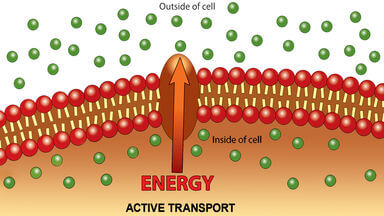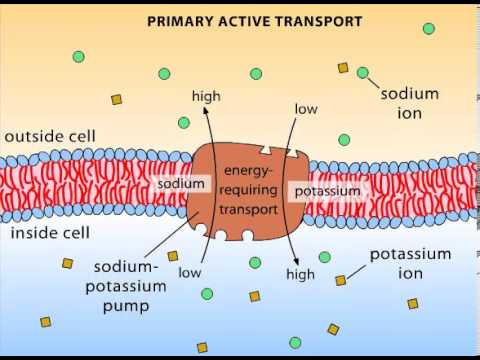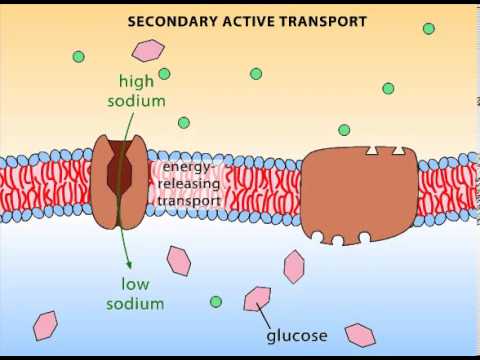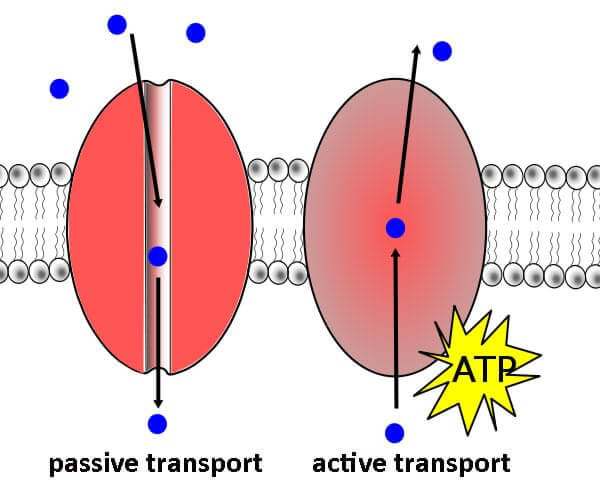Active TransportIn cellular biology, the movement of molecules from lower concentration to the higher concentration through membrane is known as active transport. The movement of active transport necessitates the use of cellular energy. Active transport can be categorized into, ATP-based primary active transport and electrochemical gradient-based secondary active transport. The uptake of glucose in the intestines in human body is a simple example of active transport. 
Active Transport divided into:
1. Primary Active TransportPrimary active transport or direct active transport uses metabolic energy to transfer molecules across a membrane. Metal ions, such as Na+, K+, Mg2+, and Ca2+, are examples of molecules moved across the cell membrane through primary active transport. Ion pumps/channels are required to cross membranes and distribute charged ions throughout the body. Transmembrane ATPase enzymes are involved in this form of transportation. 
The sodium-potassium pump is the most basic form of primary active transport found in all animal life and is responsible for maintaining cell potential. The sodium-potassium pump keeps the membrane potential constant by removing three Na+ ions from the cell and replacing them with two K+ ions. Apart from that, Primary active transport include redox energy and photon energy (light) for movements. The mitochondrial electron transport chain, which employs the reduction energy of NADH to shuttle protons over the inner mitochondrial membrane on a concentration gradient, is such example of how Redox energy is used for primary active transport. Photosynthesis is an example of active light-energy transmission. In Photosynthesis proteins use photon energy to create a proton gradient across the membrane and provides reducing power to reduce NADP to NADPH. Endocytosis, exocytosis, sodium-potassium pump are a few examples of active transport. Model of Active TransportHydrogen ions are transported against an electrochemical gradient using ATP hydrolysis (low to high hydrogen ion concentration). On contrary, Phosphorylation of the carrier protein and the binding of a hydrogen ion cause a conformational (shape) shift in the hydrogen ions, which causes them to travel against the electrochemical gradient. Once the phosphates are hydrolyzed, the carrier is rebuilt to its original form, releasing the hydrogen ion. Primary Active Transporters Types:
The P-, F- and V-classes only transport ions, while the ABC super family also transports small molecules. Some examples of amount of energy produced by cells to maintain the concentration gradients between ions and plasma are given below:
2. Secondary Active TransportOn contrary to Primary active transport the secondary active transport uses electrochemical gradient energy produced by active transport for movement of ions or molecule across gradients. The energy stored in these gradients is used to move other molecules against their gradients in secondary active transport. 
The movement of sodium ions down their gradient relates to the upward transport of other substances via a common carrier protein in secondary active transport (a cotransporter). A carrier protein, for example, allows sodium ions to flow down their gradient while simultaneously bringing a glucose molecule up the gradient and into the cell. The sodium gradient provides energy to the carrier protein, which drives glucose molecule movement. The Secondary active transport is needed to store high-energy hydrogen ions in the mitochondria of plant and animal cells to produce ATP. In secondary transport two molecules that are transported may move in the same direction (i.e., both into the cell) or different directions in secondary active transport (i.e., one into and one out of the cell). The protein that transports them is called a symporter when they travel in the same direction and an antiporter when they move in opposite ways. Endocytosis and exocytosis are two mechanisms that transfer materials through cell membranes through secondary active transport. The cellular membrane folds over the molecules being carried during endocytosis, forming vesicles that migrate from one side to the other. Enzymes may digest substances brought into the cell via endocytosis in some instances. Viruses use a different form of bulk transport to enter the cell. When the viral membrane and the cellular membrane merge, the DNA is forced into the host cell. Two types of Endocytosis
Pinocytosis and phagocytosis are two kinds of endocytosis. Pinocytosis is a process where cells in the small intestine absorb liquid particles such as fat droplets. Similarly, Phagocytosis is the absorption of solid particles by cells. Exocytosis occurs to eject material by fusing outer cell membranes cells with a vesicle membrane. Exocytosis is the process through which neurotransmitters are transferred between brain cells. Biological significanceActive transport is required for a variety of biological functions. It's used in a lot of biological processes (e.g., proton gradient generation in chloroplasts and chemosynthesis in mitochondria). PhABCG1 is an ABC transporter which involved volatile organic chemicals across the plasma membrane in plants in the active transport. This is important for plants because pollinators and seed-dispersal organisms are attracted to volatile organic molecules. Plants actively transport antimicrobial metabolites through ABC transporters, particularly NtPDR1. Active transport is performed in plant to absorb nutrients such as chlorine and nitrates from the soil into the vacuole. In humans and animals, active transport is performed in various metabolic activities, such as, glucose absorption. Common misunderstandings:Facilitated diffusion is not same as active transport. Proteins are used in both active transport and assisted diffusion to aid in transport. On the other hand, active transport acts against the concentration gradient, transporting chemicals from low-concentration locations to high-concentration ones. Furthermore, the proteins that they use are different. Carrier proteins are not channel proteins, and are used in active transport. These carrier proteins differ from those seen in assisted diffusion because they require ATP to change shape. Because chemicals can only flow through channel proteins along a concentration gradient, they are not utilized in active transport. Some of the differences between Active transport & Passive transportPassive transport is one of the processes used by a cell to move substances across a biological membrane. This transport differs from active transport. As in active transport substances move against the direction of concentration gradient. Whereas, in passive transport, the movement of substances occurs along the direction of concentration gradient. 
In active transport, substances such as ions, glucose, and amino acids travel from lower concentration to higher concentration in membrane. Active transport refers to the movement of molecules across a membrane across a concentration gradient from the lower concentration area to a higher concentration region. The movement of active transport necessitates the use of cellular energy.
Next TopicAnimal Cell
|
 For Videos Join Our Youtube Channel: Join Now
For Videos Join Our Youtube Channel: Join Now
Feedback
- Send your Feedback to [email protected]
Help Others, Please Share










